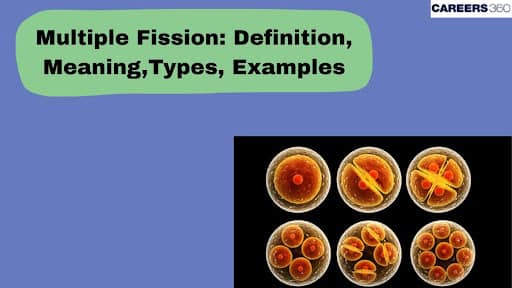Multiple Fission: Definition, Meaning,Types, Exampale
Multiple fission is a form of asexual reproduction that is seen in unicellular organisms like protozoa. Multiple fissions result in the formation of many daughter cells from a single parent. This process allows fast multiplication, which is really beneficial for adaptation and habitat in an unfavorable environment. Multiple fission is an important topic in class 12th biology.
This Story also Contains
- What Is Multiple Fission?
- Process Of Multiple Fission
- Examples Of Organisms Exhibiting Multiple Fission
- Multiple Fission: Its Importance
- Multiple Fission Vs Binary Fission
- Recommended video on Multiple Fission

The organisms that perform multiple fissions often develop a protective cyst to fight harsh conditions. Inside that cyst, the nucleus divides many times, after which the division of cytoplasm occurs. This then results in the formation of multiple daughter cells. This article provides a detailed insight into what multiple fission truly is, the process of multiple fission, examples, and the differences between binary fission and multiple fission.
What Is Multiple Fission?
Multiple fission is a type of asexual reproduction. It involves a single parent where the parent cell undergoes division to form many daughter cells. This is different from what happens in binary fission. Binary fission involves one parent cell that divides to form two daughter cells. In this process, the parent cell divides into several daughter cells almost simultaneously. Multiple fission is a great method to increase the population quickly under unfavourable living conditions, and where resources are plentiful.
Also Read:
Process Of Multiple Fission
It is clear that multiple fission is a form of asexual reproduction, which results in the formation of multiple daughter cells. Here are the steps involved in the process and mechanisms behind it, along with their significance in survival and reproduction. Given below are a few pointers explaining the process of multiple fission:
Multiple fission generally occurs by individual induction of environmental factors like temperature, change in pH, and nutrient availability.
It may be divided into successive stages of processes.
In these, the parent cell may undergo encystment by forming a protective cyst or shell around it to withstand unfavourable conditions.
In the process of nuclear division, the nucleus of the parent cell, inside the cyst, undergoes repeated division to form a lot of nuclei.
In the process of cytokinesis, the parent cell's cytoplasm divides into many daughter cells, each having one nucleus.
During excystment, when the environmental conditions turn favourable, the cyst wall bursts open, and the daughter cells emerge as free-living organisms, ready to grow and divide further.
Examples Of Organisms Exhibiting Multiple Fission
Examples are important for clearly understanding how multiple fission works in real life. By studying these, a better knowledge of practical application is gained. Here are a few examples of organisms that exhibit multiple fission:
Multiple fission occurs in several protozoans, for example, Plasmodium, the malaria parasite, and Toxoplasma, during certain stages of their life cycle.
In the case of the Plasmodium life cycle, for example, multiple fission occurs within the liver as well as the red blood cells of its human host.
This results in extremely fast multiplication of the parasite and the subsequent severe outbreak of malaria.
Multiple Fission: Its Importance
Understanding the importance of multiple fissions is very necessary when studying how reproduction in organisms adapts to harsh conditions. Given below are a few pointers that explain why multiple fissions are beneficial for the survival of species under stress or resource-limited conditions.
Multiple fission is, in turn, a very efficient method of asexual reproduction that allows the rapid generation of a large number of genetically identical offspring.
This is a very effective approach in high-resource, low-competition areas.
Further, the ability to form protective cysts can enable an organism to survive in adverse conditions and disperse to new habitats.
Multiple Fission Vs Binary Fission
To clearly understand the reproductive strategies of unicellular organisms, it is very important to compare two common types of asexual reproduction: binary fission and multiple fission. Despite being fissions, binary and multiple fissions have some distinctions. Here is the table given below, which clearly shows those differences:
Feature | Binary Fission | Multiple Fission |
Number of Daughter Cells | Two identical daughter cells | Many daughter cells |
Division Frequency | Nucleus and cytoplasm divide once | Nucleus divides multiple times before cytoplasmic division |
Occurrence Conditions | Takes place in favorable conditions | Takes place in unfavorable or dormant conditions |
Type of Organisms | Common in Amoeba, Paramecium, and Bacteria | Common in Plasmodium, Amoeba (in cyst form) |
Speed of Process | Quick process | Slower, involves a dormant period |
Survival Strategy | For regular growth and reproduction | For survival during harsh conditions |
Protective Structure | No protective cyst formation | Usually occurs inside a cyst or protective covering |
Other Useful Resources:
Recommended video on Multiple Fission
Frequently Asked Questions (FAQs)
In binary fission, a parent cell has a single division to produce two daughter cells. In multiple fission, on the contrary, the parent cell divides to form many daughter cells all at once.
Multiple fission largely takes place in protozoans, particularly Plasmodium and Toxoplasma.
In this process, the parent cell can form a protective cyst around itself to withstand any unfavourable environmental conditions.
It simply means that Plasmodium rapidly multiplies inside its human host, causing malaria and hence propagating the parasite in other hosts.
In the case of multiple fission, many offspring are produced in a very short period. This is advantageous when the environment has ample resources and little competition.